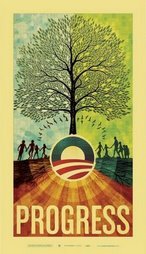I'm starting to think about this adventure in becoming more sustainable as a journey down a really long road. I've been walking much slower than I would like so far, but I know that if I just keep putting one foot in front of the other, I'll get there. Corny analogy? Maybe, but it's working for me right now, and I'm sticking to it. That makes this the first post in a very long series to come that will chronicle each small step (including the occasional backward one) down the road.
On Wednesday night, I started my very first batch of homemade bread. I chose the no-knead variety, mostly because I'd heard it was easy and thought that would make me more likely to continue baking bread. I found the recipe in the New York Times, of all places. I made it exactly as instructed the first time, and plan variations in future iterations.
Here's a picture of the resulting loaf.Recipe: No-Knead Bread
Adapted from Jim Lahey, Sullivan Street Bakery
Time: About 1½ hours plus 14 to 20 hours’ rising3 cups all-purpose or bread flour, more for dusting (I used half white, half wheat)
¼ teaspoon instant yeast (I used Fleischmann's Rapid Rise Yeast)
1¼ teaspoons salt
Cornmeal or wheat bran as needed. (I skipped this for now)
1. In a large bowl combine flour, yeast and salt. Add 1 5/8 cups water, and stir until blended; dough will be shaggy and sticky. Cover bowl with plastic wrap. Let dough rest at least 12 hours, preferably about 18, at warm room temperature, about 70 degrees. (I started my bread at 11:30 pm, in the hopes that it would be ready when I got home the next day. This seems to have been a fairly successful strategy.)
2. Dough is ready when its surface is dotted with bubbles. Lightly flour a work surface and place dough on it; sprinkle it with a little more flour and fold it over on itself once or twice. Cover loosely with plastic wrap and let rest about 15 minutes. (I didn't get to this step until 20 hours after I started the dough. In retrospect, this may have resulted in too many air bubbles, which could be why the texture was a bit odd.)
3. Using just enough flour to keep dough from sticking to work surface or to your fingers, gently and quickly shape dough into a ball. Generously coat a cotton towel (not terry cloth) with flour, wheat bran or cornmeal; put dough seam side down on towel and dust with more flour, bran or cornmeal. Cover with another cotton towel and let rise for about 2 hours. When it is ready, dough will be more than double in size and will not readily spring back when poked with a finger. (Here's where I started thinking the recipe had gone horribly wrong. My dough was much too gooey to form into a ball, and no amount of flour on my hands or the dough was going to prevent sticking. But I perservered. After the two hours, my dough had not doubled. It did not even grow by 50%. It also continued to spring back at this point, but I refused to give in and chuck this batch.)
4. At least a half-hour before dough is ready, heat oven to 450 degrees. Put a 6- to 8-quart heavy covered pot (cast iron, enamel, Pyrex or ceramic) in oven as it heats. When dough is ready, carefully remove pot from oven. Slide your hand under towel and turn dough over into pot, seam side up; it may look like a mess, but that is O.K. Shake pan once or twice if dough is unevenly distributed; it will straighten out as it bakes. Cover with lid and bake 30 minutes, then remove lid and bake another 15 to 30 minutes, until loaf is beautifully browned. Cool on a rack. (I used our Le Creuset baking dish, which seems to have worked very well. This loaf needed just 15 minutes with the lid off to look and smell delicious.)
Yield: One 1½-pound loaf.

As you can see, the bread didn't rise nearly as much as anticipated. The texture is also a bit spongy, perhaps because I let it rise for too long in the first stage. But the flavor is good, and it has a great crust on it, so I'm thinking this was a fairly good first effort.
If anyone out there has more information on what I might want to do differently next time, including maybe changing the kind of yeast I used???, please let me know. For my next loaf, Rob has requested a full-on kneaded bread, so please also pass along any great recipes of that variety.
Hmm. Now I'm looking forward to spreading a bit of locally produced goat cheese on a couple of slices of yummy fresh bread....











3 comments:
NOT BAD FOR YOUR FIRST LOAF!! Matt has adapted the recipe a bit (I think). He posted about it here:
http://tinyurl.com/577vnr
Maybe that helps? I don't know. He's been making it for years, so feel free to email him about it, too!
Did you get this recipe from Mother Earth News a few months back? Weird - if not - because I think it is the same exact one.
to my sister,
Thanks for the encouragement - I was thinking this attempt was somewhat of a failure, but maybe I should think of it as mostly successful instead. After a bit of online research, I suspect that I used the wrong type of yeast, but I'll definitely follow up with Matt after he has a few days to settle into the new job. I may try his recipe next...
elise,
Strangely, I found this recipe on the New York Times website about six or eight weeks ago. I printed it out, set it on a shelf with the cookbooks, and told myself I'd try the recipe later. Can you tell I believe in (at least a little bit of) procrastination?
At any rate, I think there are several different adaptations of this recipe floating out there. Melinda's (yes, she's my sister) comment above links to the one she and her husband make nearly every week.
Did you have success with your version of the recipe?
Post a Comment